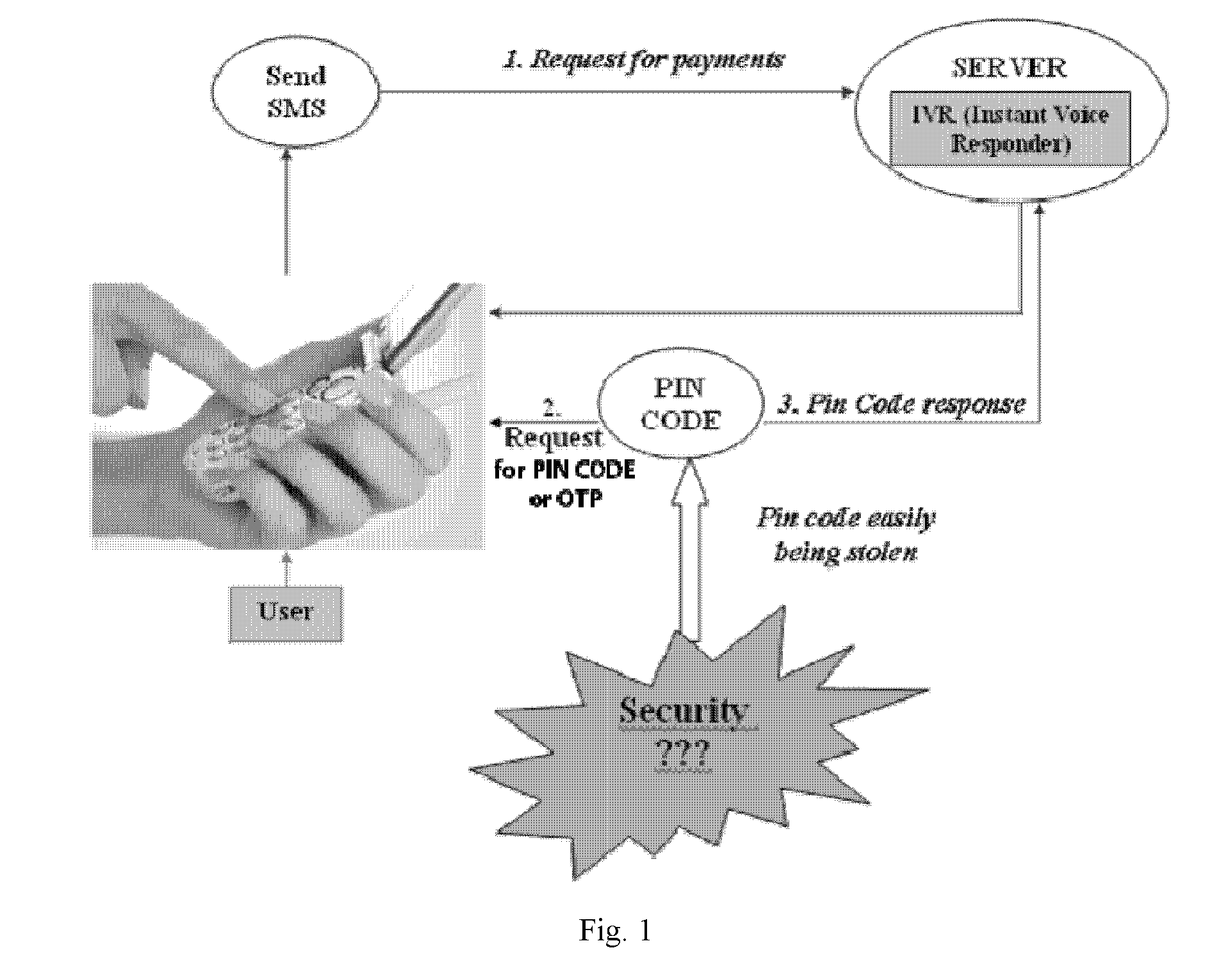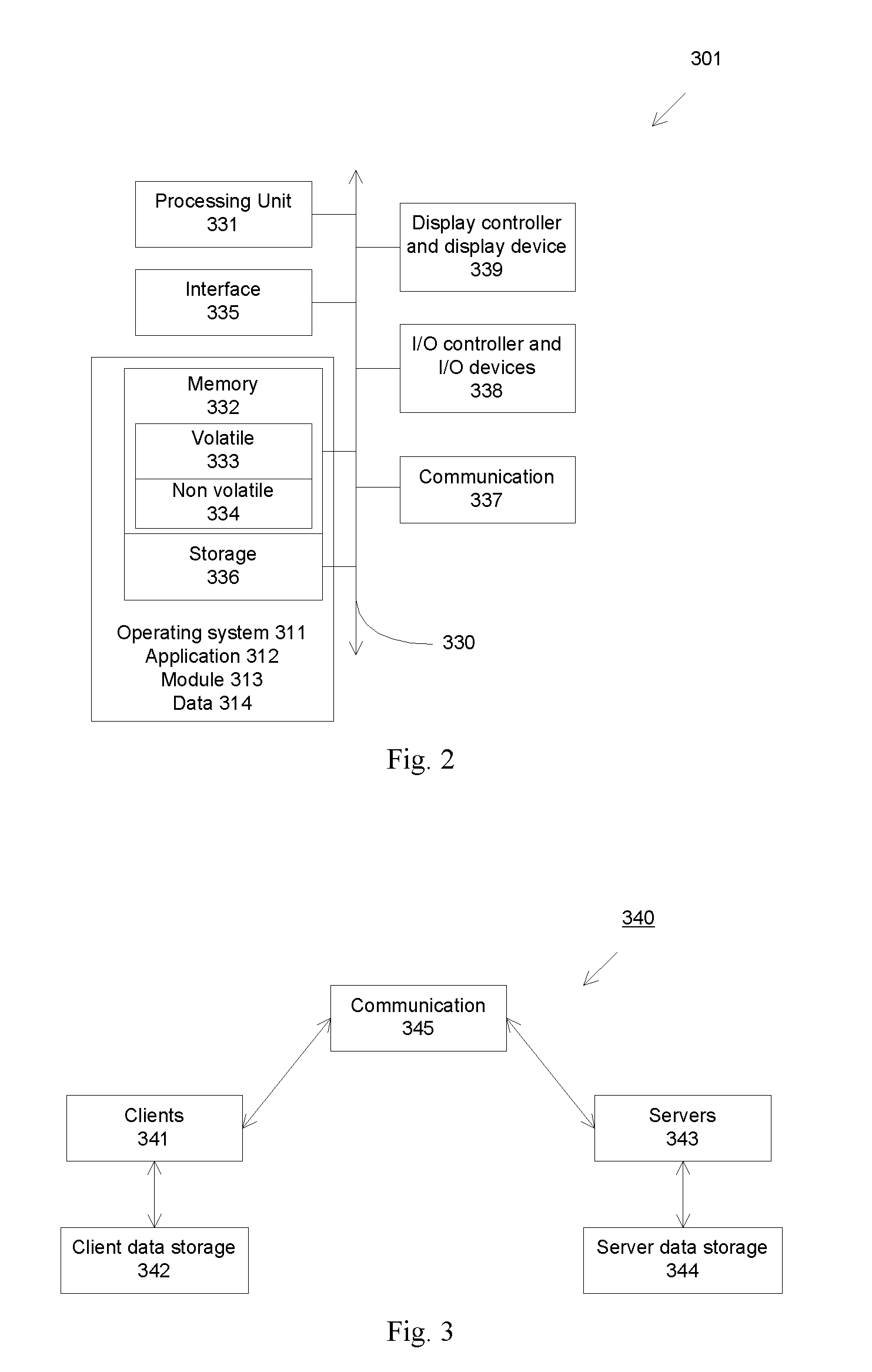[0012]The present invention provides computer-enable certification and authentication in, for example, e-commerce with wireless and mobile devices. In an aspect, the present authentication and certification use a strong multi-factor (more than 2) authentication method and
application software embedded in the
mobile device, allowing the issuer of a transaction request to become authenticated, to have his status verified, to have his order non-refutably certified and executed without any addition input from the issuer.
[0013]In an embodiment, the present invention describes systems and methods to permit a sender, with a
mobile device, to send messages, such as transaction requests, to a receiving
server. The receiving
server must recognize and authenticate the sender and / or the sender device, for example, verifying that the sender has all the right factors which are registered, and / or assigned by, the
server to execute certain types of transactions, certifying that this transaction request was sent by an approved mobile device, and then sending confirmation
receipt at the execution of the transaction. In an embodiment, the present invention discloses methods and apparatuses to authenticate and certify messages sent from a sender or a sender device, such as a
cell phone. The present invention further provides ease of operation, for example, by automatically embedded an authenticate passcode to the message, all without the sender's intervention. The passcode is preferably a one-time passcode, which can further enhance the security of the authenticate process. In an embodiment, the present authenticate comprises composing a message at a sender or a sender device, such as a
mobile phone, and then sending the message and a sender identity to a
receiver device, such as a server. Before sending the message, a one-time passcode is automatically generated and embedded to the message without any sender's input. The one-time passcode serves to authenticate the message, certifying that the message is indeed generated from the sender or the sender device. After an authentication process, a confirmation is received to acknowledge the message. In an aspect, the present authentication process further provides that the one-time passcode is recorded with the message, thus enabling certification that the message has been authenticated.
[0014]In an embodiment, the present authenticate method comprises composing a message, then automatically generating a one-time passcode without any sender's input. The automatically generated one-time passcode is then automatically embedded in the message, again without any sender's input. When the sender presses a send button, the message, including the embedded one-time passcode, is sent to a
receiver device. The one-time passcode is generated and embedded automatically when the sender sends the message, thus simplify the process of
secure communication between the sender / sender device and the receiver devices. In an aspect, the one-time passcode is preferably generated from an embedded
algorithm utilizing one or more features unique to the sender and the sender device. For example, the features can be a phone number of the sender mobile device, an International Mobile Equipment Identity (IMEI), a unique industrial ID number of the mobile device, for example, in case of
GSM or UMTS devices, a particular version of the one-time passcode
algorithm, a unique security key for the receiver device, a
password chosen by the receiver device, or the date and time of sending. The features can also be personal information of the sender / sender device, for example, birthday, social security, or a
password, such as an
alphanumeric password or a biometric password.
[0016]In an embodiment, the present authentication method is utilized in an unsecured environment, for example, in a wireless or
mobile phone network. To provide further security, the sender can login to a server account, for example, a financial institution such as an online banking. The login process can also constitute a password, for example, an
alphanumeric or a biometric password. After composing a message, a one-time passcode is then automatically generated and embedded to the message. Before sending the message, the sender can input another password to confirm the message sending. The passwords, provided at the account login and at the sending confirmation, can serve to provide a secure environment, for example, against the loss of the mobile device.
[0018]In an embodiment, the present authenticate method comprises pre-arranged information between the sender / sender device and the receiver devices, thus avoids sending sensitive information, especially in unsecured environments such as wireless or
telephone network. The
present method comprises only sending a message including a one-time passcode and a sender / sender device identity. The one-time passcode is generated from an algorithm embedded in the sender device, with the algorithm utilizing one or more features stored in the sender device. The one or more features are pre-arranged to also be stored in an account at the receiver, which can be identified by the sender / sender device identity. In addition, the algorithm can also be pre-arranged, e.g., having the same algorithm, between the sender / sender device and the receiver so that a same one-time passcode is generated with the same inputs of the one or more features.
[0022]The present invention further discloses a mobile device, such as a
cell phone, or a personal device assistance (PDA) for transmitting authenticate message. The mobile device comprises a communication module for transmitting and receiving message; a keypad module for composing message with the keypad module comprising a send button for sending a message; a one-time passcode generator employing one or more features stored in the mobile device, such as features unique to the mobile device, or information related to the sender / sender device; and a processor for automatically generating and embedding a one-time passcode to a message before sending. The present invention further discloses a server for authenticate received message. The server comprises a communication module for transmitting and receiving message; a module for extracting a sender / sender device identification and a one-time passcode from the message; a one-time passcode generator employing one or more features stored in an account identified by the sender / sender device identification; and a processor for automatically generating and comparing a one-time passcode to a generated matching passcode. Other embodiments can be provided, for example, a
system comprising an authenticate server and a plurality of mobile devices for
secure transmission of messages.
 Login to View More
Login to View More  Login to View More
Login to View More 


